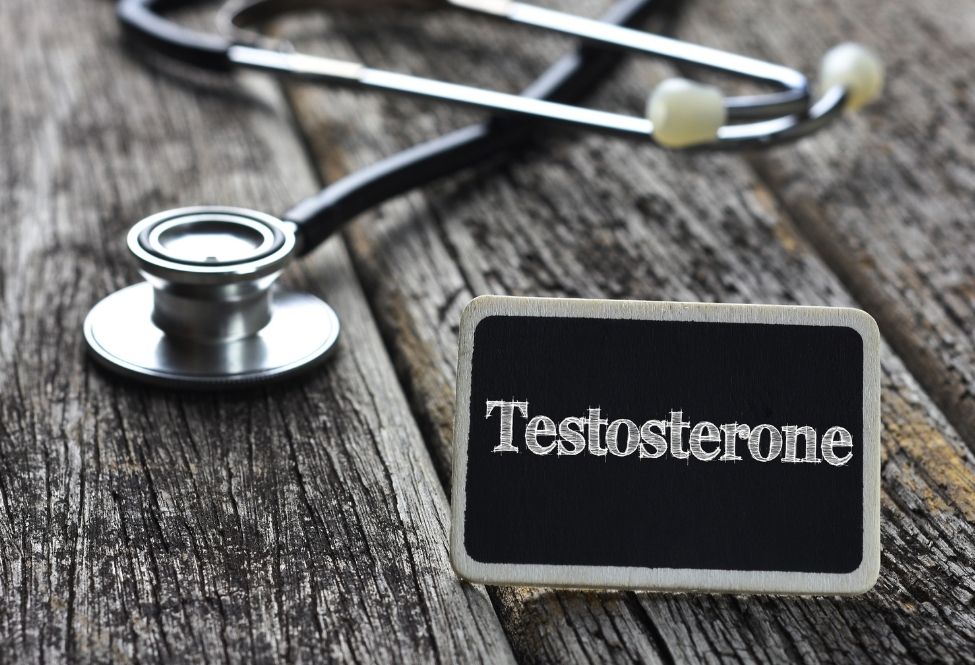All women go through menopause around the age of 50 and it’s definitely more severe than testosterone deficiency in men. However, even men do get affected by this, causing them to lose muscles, having less drive, gaining weight, and more. Unlike women, not all men go through this. Only around 15%-20% of men go through “andropause” or rather age-related testosterone deficit syndrome. Testosterone deficiency is difficult to diagnose, but there are hormone treatments that can help with this. Two treatments are currently available and those are testosterone gel and injectable dosage forms.
Want to learn more? Keep reading the article by Dr. Catherine Waeber Stephan.
The shock is less severe than for women who are all in menopause around 50 (90% between 48 and 52), but men also feel the effects of hormonal fluctuations: less muscle, less drive, more belly, …
The male’s role in reproduction is to fertilise sperm (between 300 and 500 million/day), to fertilise his wife during conception and also to produce testosterone so that he is “fit and in shape” for hunting and to procure food for his family (at the time of the cavemen).
Testosterone and sperm are produced independently, while women produce their sex hormones (oestrogens and progesterone) during their menstrual cycle and in parallel with the maturation of the eggs. In women (who died young in previous centuries), the supply in the ovaries diminishes from the age of 35 and the menopause (cessation of menstrual bleeding) inevitably occurs around 50 (see the booklets “Menopause and all conditions: before, in, after and otherwise”). This is not the case with men, who therefore do not necessarily have an “andropause”.
Only 15 à 20% of men are affected by the “age-related testosterone deficit syndrome” or A.D.A.M. (androgen deficit of the ageing male).
AGE-RELATED TESTSTERONE DEFICIT SYNDROME: NO SIMPLE DIAGNOSIS
The regulation of hormone production works on the principle of the thermostat, while the effect of the hormone on the target organ works like a key used to unlock a door, or a fuel cap. The hormone is the key, the lock is the hormone receptor, and the opening of the lock is the effect of the hormone.
An example: testosterone docks onto the androgen receptors in the facial skin and thus stimulates beard growth. The density of the beard therefore depends on the testosterone content and the number of receptors in the skin, which is influenced by ethnicity (the beard of a Mediterranean native is thicker than that of an Asian, with the same testosterone level). The activity of testosterone is directly linked to the number of receptors in the target organ. The testosterone that acts on the target organs (muscles, bones, beard, brain, etc.) also depends on the “thermostat” in the brain (hypothalamus and pituitary gland), through the gonadotropins LH and FSH and testicular function (testosterone production).
To make matters even more complicated, the testosterone produced by the testes does not circulate in the blood in this way, but 50% of it is bound to a transport protein produced by the liver, SHBG (sex hormone binding globulin). The amount of testosterone therefore also depends on the SHBG level.
WHY DOES TESTOSTERONE PRODUCTION DECREASE WITH AGE?
With age, the function of the testosterone-producing cells in the testes decreases and the “thermostat” of the hypothalamus becomes less sensitive to the decreasing hormone levels in the blood. From 40 onwards, testosterone levels decrease by 1% per year, which means that testosterone deficiency can become symptomatic from 65 onwards: decreasing sexual desire, absence of nocturnal and morning erections, Insomnia are the signs, while erectile dysfunction, listlessness and weight gain are less specific and difficult to distinguish from the usual changes caused by age and lifestyle.
Impotence, contrary to the belief of most men who go to the doctor for erectile dysfunction, is not due to testosterone deficiency. The “miracle” of erection, its quality and its duration is the result of complex neurovascular processes. They start from the brain (libido, sexual arousal), and lead via the autonomic nervous system (parasympathetic nervous system) to the opening of the arterial vessels that fill the sponge (swelling), to the simultaneous closing of the venous blood vessels (anti-reflux) and finally to penile erection. Ejaculation and orgasm take place when the sympathetic nervous system takes over! Disturbances can then occur at any level, but in erectile dysfunction it is often the neurovascular impairments, responsible for mishaps. This is where the Viagra and comparable drugs, which are not aphrodisiacs, intervene!
Nevertheless, one can understand the performance anxiety, the fear of “failure”, which leads to less frequent sexual intercourse, which is then – incorrectly! – This is then interpreted – incorrectly – as a loss of libido, although libido depends on testosterone.
WHY DO SO MANY MEN SUFFER FROM ERECTILE DYSFUNCTION THESE DAYS?
With age, it takes longer for an erection to occur, despite more intense stimulation. The decongestion (softening) is faster and the refractory period (period after orgasm during which sexual arousal decreases). The quality of orgasm is affected by the reduced quantity and speed of ejection of semen. Metabolism also changes with age, especially if lifestyle is not adapted. Sedentariness leads to lower muscle mass and increased fat mass, especially if the diet is rich in carbohydrates (and fats). This is often the case nowadays: bread, pizza, pasta, cold cuts, beer, soda drinks, etc.!
Less muscle, more belly … Why? Because sugar is used to make fat in the same way that foie gras is “made” by fattening the goose with corn and wheat (sugar) and preventing it from flying (sedentarism). A somewhat simplified but good pictorial representation to explain the rapid increase in fat bellies in men, but also in women and even children! Insulin is the essential hormone for sugar metabolism. The lack of exercise (which burns sugar) combined with a high-sugar diet (fattening) causes the pancreas to overproduce insulin, which after a few years has damaging consequences for the metabolism: abdominal obesity (belly), steatosis hepatis, the non-alcohol-related fatty liver (“foie gras”), dyslipidaemia (lowering of good cholesterol, increase in triglycerides), arterial hypertension (high blood pressure) and risk of cardiovascular disease (heart attack, stroke), but precisely also erectile dysfunction, which is a symptom of metabolic syndrome or beer belly syndrome.
After years of hyperinsulinism, sugar utilisation becomes impossible, hence the risk of developing type 2 diabetes.
For men with this problem, losing weight, muscle activity and the Mediterranean diet with lots of fish, fruit and vegetables will bring testosterone levels in the blood back to normal.
HOW TO TREAT DEFICIENT TESTOSTERONE PRODUCTION?
As already mentioned above, testosterone deficiency in men is difficult to diagnose, especially when the hormone content is borderline. On the other hand, hormone replacement therapy is definitely indicated if testosterone deficiency is detected in 2 samples, one month apart, and the patient shows symptoms of hypogonadism. As in the case of women, hormone treatment is useful because it brings more benefit than risk (cf brochures on menopause).
In Switzerland, two treatments are currently available:
- Testosterone gel, which is applied to the skin every morning after showering.
- Injectable dosage forms (once a month or every 3 months), usually suggested for long-term therapies.
There are currently no tablets containing testosterone in Switzerland. For each form of treatment, the dose is adjusted: according to the patient’s sensation, and on the basis of the measurement results of bioactive testosterone after 3, 6 and 12 months.
WHAT CHECKS ARE APPROPRIATE BEFORE AND DURING TREATMENT?
Before starting testosterone treatment, the condition of the prostate gland must be determined by a clinical examination (palpation of the prostate, possibly echography), in conjunction with the determination of the PSA value (prostate specific antigen). By palpating the prostate gland, its volume and condition are determined; hyperplasia (diffusely enlarged prostate gland), an adenoma (benign tumour), prostatitis (usually painful inflammation of the prostate gland) or a possible cancer can be detected in this way.
The examination of the prostate is carried out as part of a general clinical examination, which also includes weight, height, abdominal circumference, high blood pressure, hairiness, palpation of the testicles, etc. If replacement therapy is planned, the clinical examinations are supplemented by laboratory tests: blood count for haematocrit level (which increases during treatment), glucose, possibly C-peptide, Insulin and the HOMA index, which corresponds to insulin resistance, HbA1c (> 7 in diabetes), total cholesterol value, HDL cholesterol (the good cholesterol), which is low in beer belly syndrome, LDL cholesterol (the bad cholesterol), triglycerides, which are often elevated in metabolic syndrome, liver tests (to detect fatty liver), ferritin to detect haemochromatosis (excessive iron in the blood), etc.
In people with proven androgen deficiency, measurement of mineral bone density is necessary to rule out possible osteopenia or osteoporosis.
In persons with proven androgen deficiency, measurement of mineral bone density (osteodensitometry) is necessary to rule out possible osteopenia or osteoporosis, to assess the risk of bone fracture and, if necessary, to suggest preventive treatment. A cardiovascular examination is recommended in men at increased risk.
TO CONCLUDE
Before using hormone replacement therapy with testosterone in men, it must be clarified through a precise diagnosis whether he is suffering from hypogonadism. Otherwise, it is like heating a room with supplementary heating, the thermostat is slowed down and so is the body’s own production of testosterone. If the patient receives more testosterone than necessary, it is doping! By 2050, 16% of men will be over 65 and 15-20% will have an age-related androgen deficit. That’s quite a lot!
For more information:
- Testosterone deficiency in men (brochure published by Bayer in 2015)
- La ménopause dans tous ses états (brochure published by Vifor Pharma in 2016), which you can find on the website www.catherinewaeberstephan.ch
- La ménopause, avant, pendant et après (in French) www.catherinewaeberstephan.ch










